
archives for 08/2016
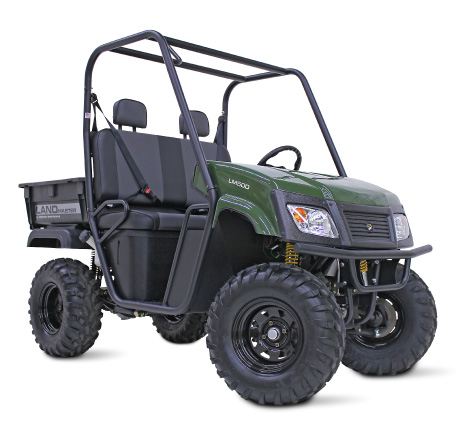 Mark: I think the best
solution for our access issues within our price range is a UTV.
Mark: I think the best
solution for our access issues within our price range is a UTV.
Anna: Well, we have been saving to solve that
exact problem and I did win the goat wars. So I
guess I can let you have your way this time.
Mark: I think the best
solution is a Landmaster 500. 479 cc engine, 8-inch ground clearance,
35x41" dump bed, 1000-lb weight limit. Suggested retail price $6,500.
Anna (after extensive
internet searching): Hmmm. I hate to say it, but that sounds like a
hobby farmer's toy. I don't think it would survive in our swamp.
Mark: Sigh.
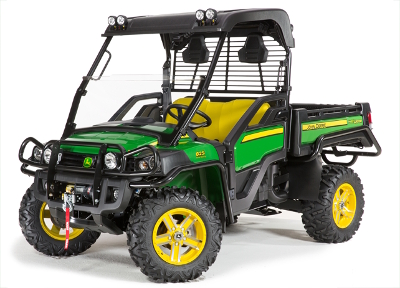 Anna: But what about this
option: John Deere Gator XUV 825i: 812 cc (50 hp) engine, 11-inch
ground clearance, 45x52" dump bed, 1400-lb weight limit, front and rear
hitch receivers, steel skid plates. Suggested retail price: $12,059.
Anna: But what about this
option: John Deere Gator XUV 825i: 812 cc (50 hp) engine, 11-inch
ground clearance, 45x52" dump bed, 1400-lb weight limit, front and rear
hitch receivers, steel skid plates. Suggested retail price: $12,059.
Mark (striking while the
iron's hot and also pushing all of my buttons like only a doting
husband can): Just think of how much manure we could haul with that!
Can we get it tomorrow?
We're not 100% decided
yet and would love to hear from folks who have used an 825i Gator in
extremely rough and muddy terrain. I know we'll have to keep adding
rocks to our swamp as needed --- the downside of any wheeled vehicle.
But do you think the John Deere can handle the muck without kicking the
bucket?
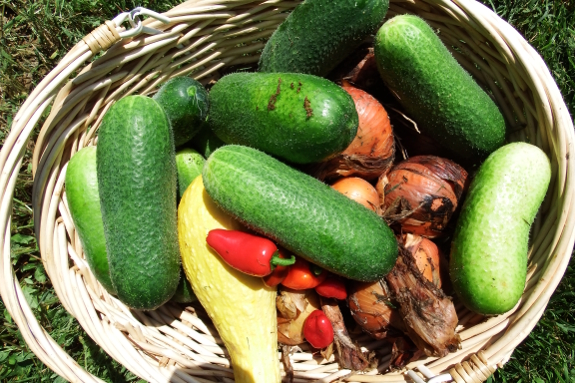
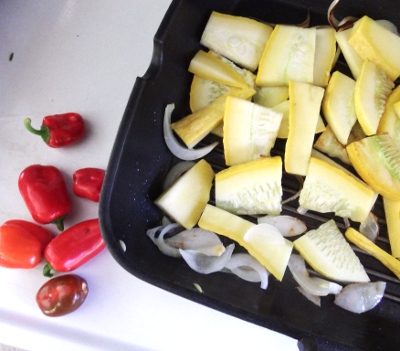 This is the time of year when
I go out to the garden to weed and come back with a basket of produce.
This is the time of year when
I go out to the garden to weed and come back with a basket of produce.
The peppers and squash
(and half of an onion) turned into our lunch, the other onions (missed
during the
main harvest) hit the drying racks, and the excess cucumbers went
to Kayla to become pickles.
Now, let's see what
comes out of the garden today....
We've 90% made up our mind
that a Kubota RTV is the right fit for us.
Advantages over the John
Deere were sealed disc brakes and a diesel engine.
The deal we are working out
saves enough cash to pay for a mechanical dump bed.
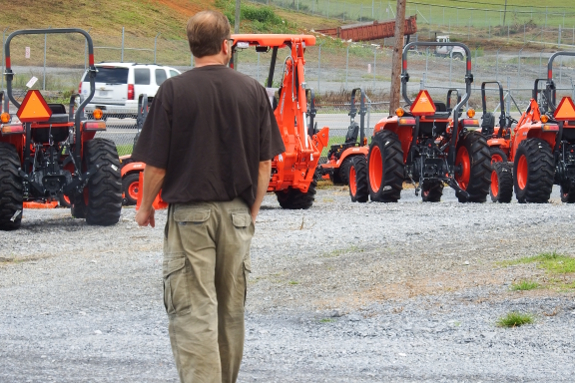
While
the majority opinion among our readers seems to be that a tractor would
be a better choice for on-farm hauling, our gut feeling is that a
UTV is still a more appropriate vehicle. We've seen tractors in our
swamp before, and the result was lots of very deep ruts and farmers who
were leery of ever setting foot on our land again.
Unfortunately, we
haven't seen UTVs in the same scenario, so we can't compare the two
types of vehicle side by side. But when we dropped by a dealership that
sells both tractors and UTVs, the salesman agreed with my analysis. He
mostly sells to farmers and they tend to use UTVs even in really mucky
terrain where cows have been fed in the same spot all winter.
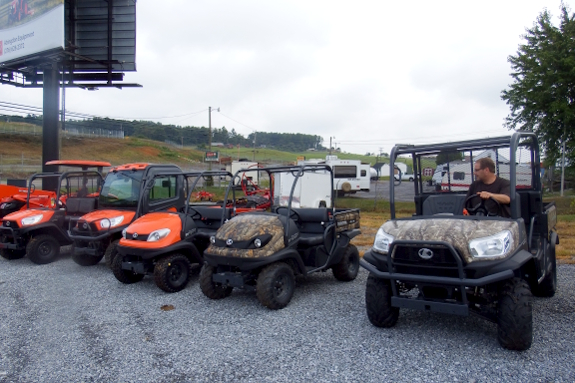
In fact, the salesman
told us about a farmer who accidentally let a wagon roll down into a
sinkhole...and ended up with a tractor down in the same wet, mucky
hole. The tractor couldn't handle the mud, but the farmer's UTV could.
Here's hoping our guess is right and a utility task vehicle can handle
our swamp.
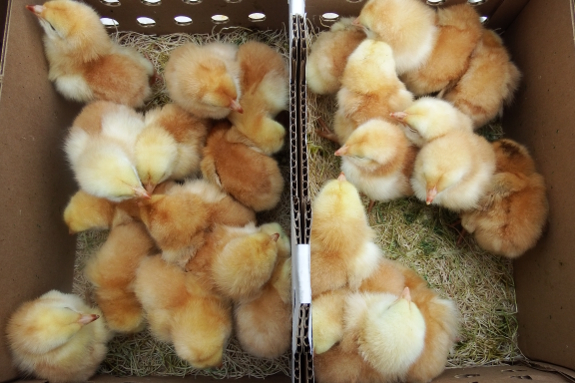
We really enjoyed the Red
Ranger broilers we
raised last year. They were fast-growing, tender and tasty, and best of
all didn't die on pasture.
So we bought another box this fall --- 25 chicks to turn into Halloween
meat. So far, all are happy and healthy and enjoying the outdoor
brooder.
Sometimes I use the string trimmer to mow the space between garden beds when the weed/grass mixture gets too tall for push mowing.
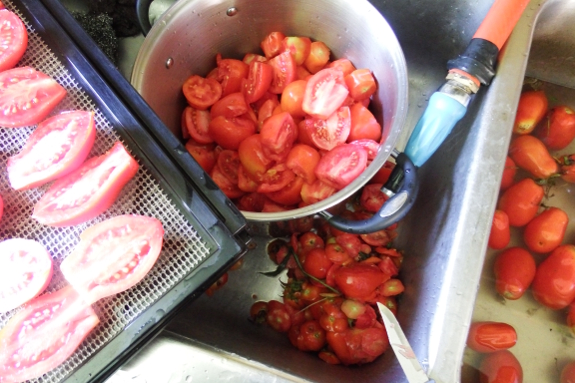
Half a bushel of
tomatoes went into the drier or soup pot yesterday. And we have half a
bushel of tomatoes with which to repeat the endeavor today.
Hollywood
sun-dried tomatoes and harvest
catch-all soup, here we come!
This time last year we stowed
9
bales of hay in the goat barn.
It ended up being impossible
to keep our goats from jumping into the kidding stall where they would
climb to the top of the tallest stack.
Maybe a loft would keep the
bales high enough or we might just keep storing it in the main barn.
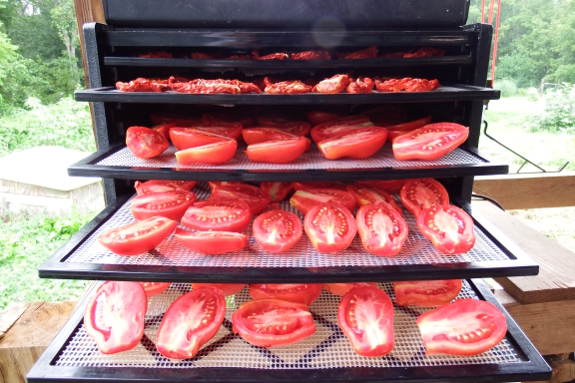
Twenty-four hours later,
I'm still prepping
tomatoes. This is the boon and bane of determinate tomatoes like
Martino's romas.
On the minus side, you have bushels of tomatoes to deal with during a
few-week span. On the plus side...the plants ripen up most of their
fruits before the blight takes the vines all the way down.
In our wet garden, the pros definitely outweigh the cons. Our winter
bellies will be grateful for the summer bounty!
We had our Kubota X900
delivered on Friday.
The first test was a wet one
due to recent rains.
Hauling a dump bed full of
horse manure and two passengers at a steady rate of 2.5 miles an hour
seems to not make any ruts.
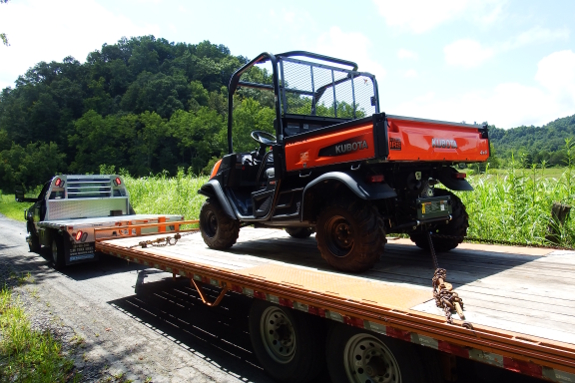
On the one hand, I'm
really tempted to skim over the rest of our decision-making process and
jump to the fun part --- our new UTV! But I know that many of you read
our blog precisely for the nitty gritty details. So here goes....
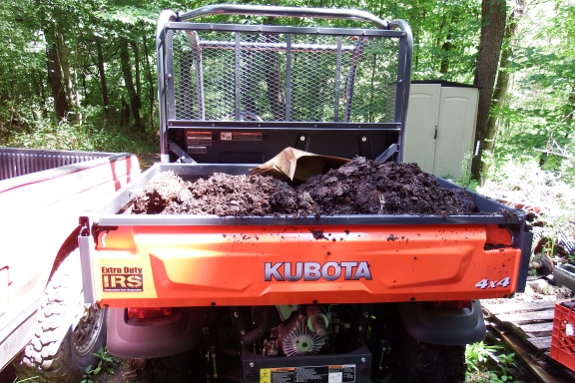
The John
Deere Gator XUV 825i
looked really good on paper. But Mark's friend in the construction
industry recently went for Kubota UTVs. And when Mark learned that the
Kubota X900 is a diesel, has sealed hydraulic brakes (to keep out
mud...we hope), and places the radiator up high for cleaner air intake,
he was sold.
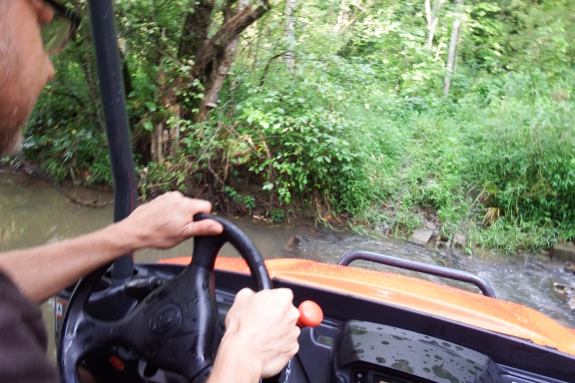
Although we usually buy
everything as cheaply as possible and I've never owned a vehicle less
than 12 years old, used wasn't even on the table for this purchase.
We've been burned pretty badly with used ATVs in the past, and when
your off-road vehicle fails way off road, you're thoroughly sunk. So we
took notes and went to the dealership to see if our savings would cover
the X900.
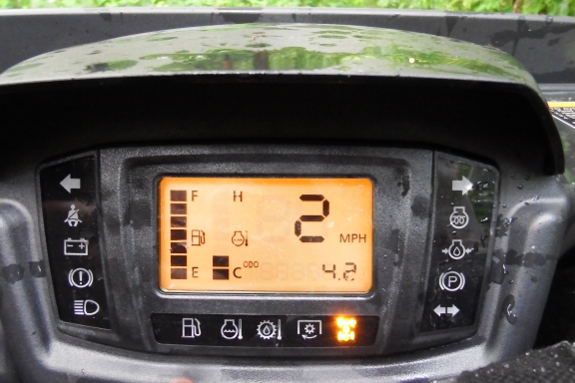
Although the base model
(no hydraulic dump bed) was listed at $13,345 online, the dealer quoted
us $11,900...and mentioned that we could get $400 off and free delivery
by paying in cash. Since I'd gritted my teeth and prepared for the
online price tag, we opted to upgrade to the hydraulic dump bed (an
additional $1,100) to expedite the inevitable rip-rap hauling. We don't
sell our vegetables to others, so we had to add on sales tax ($662.50),
which brought the final price tag to just a little below the online
base price.
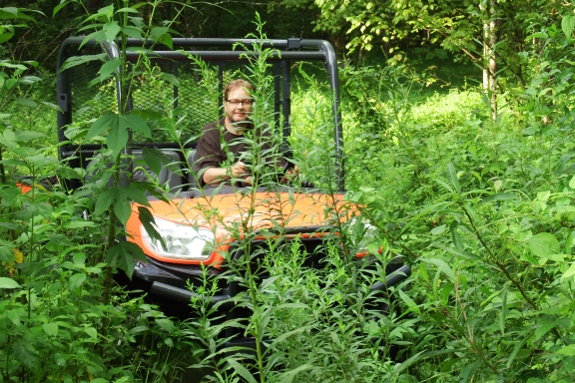
We'd been saving and
planning to spend $10,000 on access this winter, so we didn't go too
far over budget. That said, it was
terrifying to clean out so much of our buffer in one fell swoop.
On the other hand, when
Mark toodled through the floodplain without a single skid or spin (no
ruts!) and then dumped a load of manure by the worm bin, it all felt
worthwhile. And when I went for a walk the next morning and didn't have
to load up fifty pounds of manure or feed to haul back home on my back,
simply enjoying the beauty of the day instead, I knew we'd made the
right decision.
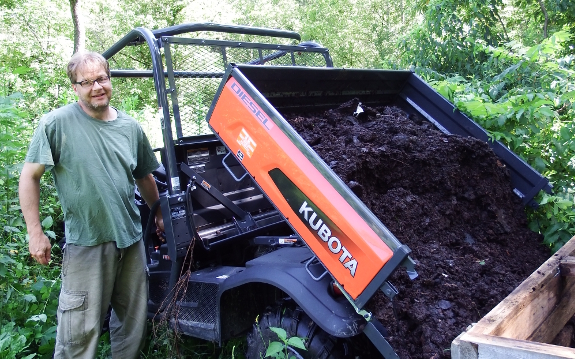
Our long-term goal is to
grow old here on the farm, and that means putting our funds toward the
necessary improvements to ensure we can continue to thrive with our
chosen way of life. Hopefully the Kubota X900 will be as valuable a
step in that direction as were our porches
and roofs.
Next up: reading the 96
page manual so we do everything right.
We lost 10 chicks recently to
a Black Rat Snake attack.
Anna caught it in the act of
killing and I captured it with a DIY
critter catcher.
Both Anna and I appreciate
snakes and could not bring ourselves to kill it.
The plan is to keep the
remaining chicks inside till I upgrade the chick brooder.
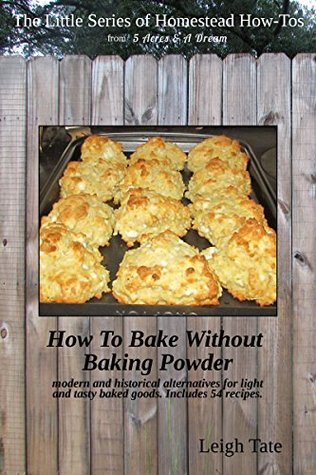 I always enjoy Leigh Tate's
books, and her newest is no exception. But before I sing its praises, I
want to make sure you don't miss out on her big summer giveaway. There
are seven prizes --- one paperback version of How to Bake Without
Baking Powder and six ebooks with topics ranging from growing ginger to
making your own whitewash. To enter, all you have to do is leave
a comment on her blog.
Good luck!
I always enjoy Leigh Tate's
books, and her newest is no exception. But before I sing its praises, I
want to make sure you don't miss out on her big summer giveaway. There
are seven prizes --- one paperback version of How to Bake Without
Baking Powder and six ebooks with topics ranging from growing ginger to
making your own whitewash. To enter, all you have to do is leave
a comment on her blog.
Good luck!
Okay, back to the book
review. Tate outdid herself with her newest book, which is chock full
of both historical data and actionable information. If you're like me,
you probably understand the basics of baking powder/baking soda --- you
can use the latter if you include an acid, but need the former if you
don't. But I've been left scratching my head many times when I saw a
recipe that called for baking soda without anything I considered an
acid to prompt the leavening reaction. Tate's book explained why,
listing many culinary acids I hadn't considered and also explaining
that baking soda actually causes some rising action by itself at high
temperatures (such as in cookies).
Then she delves even
deeper, looking at other ways you can get baked goods to rise without
purchasing either baking powder or soda. Beaten eggs are a moderately
mainstream method, but have you ever heard of the idea of soaking wood
ashes and using that alkaline liquid along with an acid to puff your
biscuits up? If the world comes to an end and baking soda is no longer
available in the grocery store, you'll definitely want this book! And,
in the meantime, the copious recipes at the end would be a really fun
homesteading and/or homeschooling experiment to combine science with
lunch. Actually, as I type this, just looking at the recipes is making
me hungry....
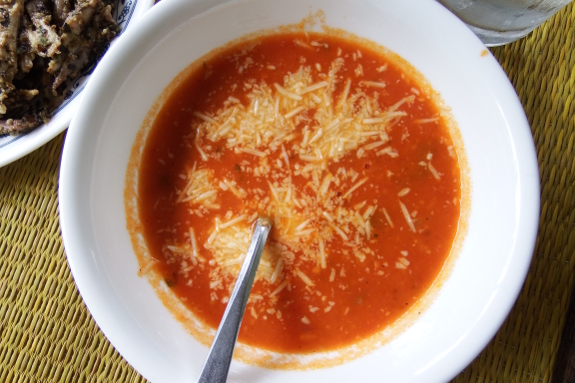
We love harvest
catch-all soup, but
sometimes eating it endlessly in the winter gets a little old. So I
decided to expand our repertoire this year to include a second soup ---
farmstead tomato.
 Our new soup includes:
Our new soup includes:
- 1 gallon of fresh tomatoes (which squeeze down to about half a gallon of tomato mush)
- 6 cups of chicken stock
- 6 onions
- 6 cloves of garlic
- 1/2 to 1 cup of fresh basil leaves
- 1 cup of fresh goat milk
- salt, pepper, and honey to taste
The soup is almost too
easy to make. I cut tomatoes into large chunks while topping them and
removing spots (leaving skin and seeds in), then squeeze the result
with my hands to assist the break-down process.
After adding the chicken
stock, onions, and garlic, I simmer for about an hour and a half. Then
I cool the soup for about half an hour before adding the basil and
blending it in well with an immersion blender.
Finally, I pour in the
milk and add salt, pepper, and a bit of honey (more sweetening if the
tomato plants are blighted, less if they're not).
The result is about a
gallon of deliciously creamy tomato soup with every ingredient except
the salt and pepper coming straight from the farm. Enjoy!
We retired a few older hens
yesterday and I used a cut resistant glove for the first time (Thanks
Mom).
It feels safer than a leather
glove and easier to clean.
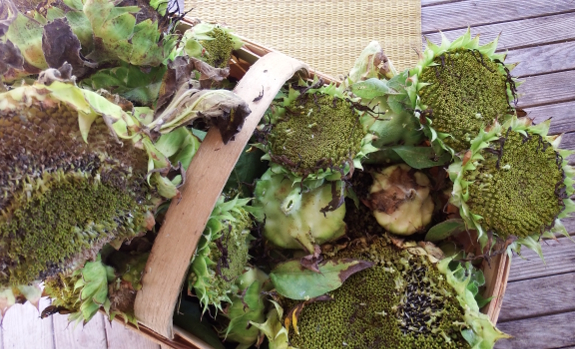
Last year, our
sunflowers had trouble germinating (or, more likely, critters ate the
sprouting seeds). This year, Mark had the bright idea of starting seeds
inside and transplanting, which worked like a charm.
On the other hand, a
week and a half of daily rain during harvest time meant I put off
cutting heads in hopes they'd dry rather than mold...so cardinals got
half the ripening seeds. What's your bright idea for next year, Mark?
We've used the Kubota X900
twice now and it continues to exceed our expectations.
I'm thinking of deleting the
wire mesh barrier between the dump bed and the seats to make hauling
lumber easier.
Those two 2x4's sticking out
hit something solid and busted a bungee cord and if the mesh barrier
was gone I could have strapped them onto the front roll bar.
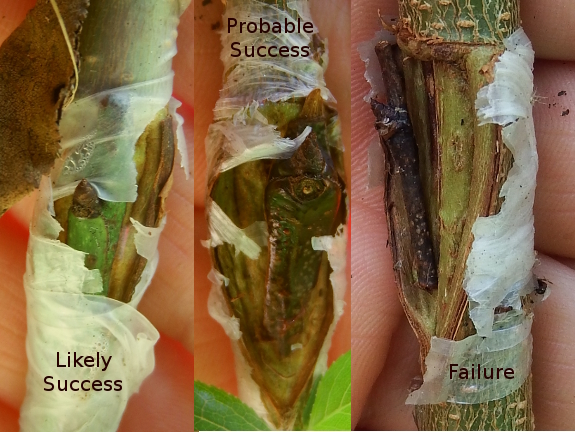
Only two weeks after bud grafting
a row of plums, I noticed that the parafilm was already breaking
away as the rootstocks swelled beyond the plastic's ability to bear. At
first I figured this was bad news...but a closer look showed that many
of the buds are still green and appear to be growing into the rootstock
as planned.
Budding is a slower
process that dormant-season grafting, so I'll just let the rootstocks
continue toodling along unchecked for the rest of this summer. Then,
during the next growing season, it'll be time to either cut above the
new buds or bend the rootstock tops over, either of which will tempt
the new variety to break bud and create new shoots.
For now, I'm just
thrilled to see that my attempts at budding appear to be at least
moderately successful. I love being able to buckle another homesteading
skill under my belt!
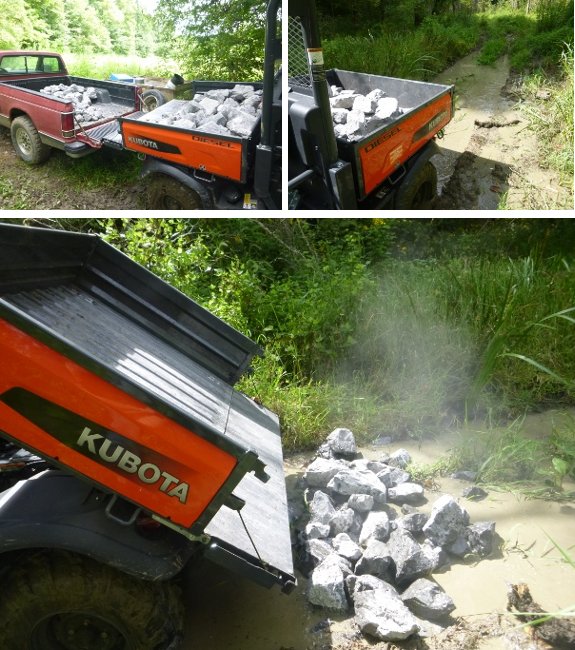
I went to the gravel store
today for 13 dollars worth of 6 inch rock.
A very smooth process we hope
to repeat several times before Winter.
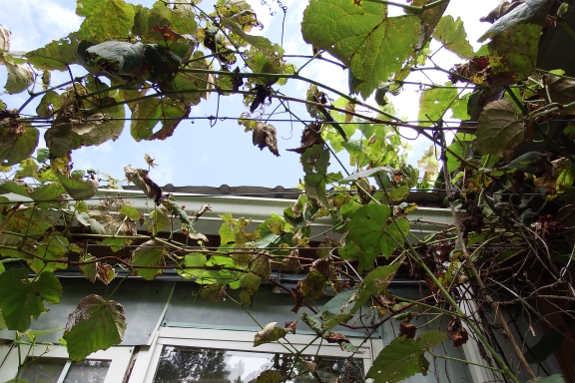
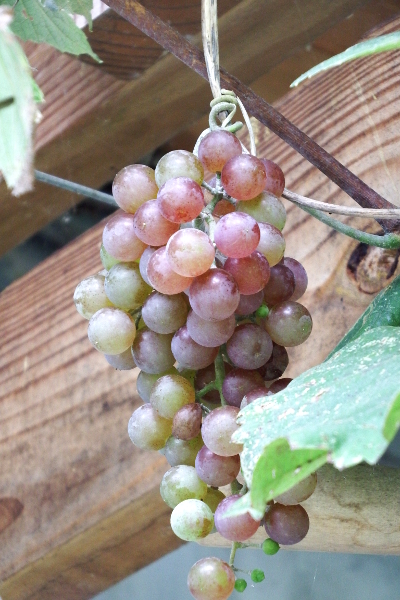 Between unreachable Japanese
beetles and unbeatable fungal diseases, the leaves of this seedless
grape don't look so hot. But the fruits merit three exclamation
points!!!
Between unreachable Japanese
beetles and unbeatable fungal diseases, the leaves of this seedless
grape don't look so hot. But the fruits merit three exclamation
points!!!
The vine set a handful
of small clusters, plus the beautiful big one shown here. I've been
picking the ripest grapes out of the smaller bundles eight per day as
our lunchtime dessert. They're so sweet that the tiny morsels go a long
way!
I'm saving the big bunch
as a special treat for visiting mothers-in-law next week. Here's your
chance to tell me you hate grapes, Rose Nell and Jayne. Otherwise, I'll
expect you to coo over the cluster as if it's your first-born
grandchild....
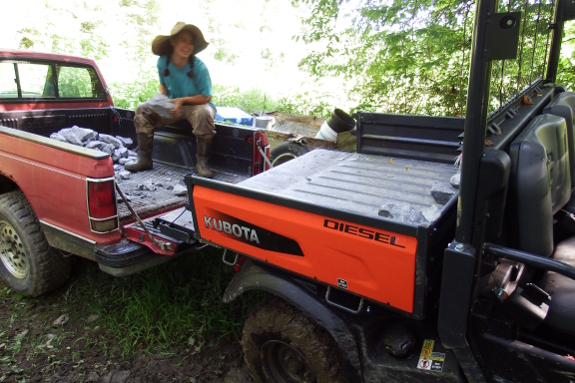
Friday morning I
couldn't resist any longer. "Can I go with you to throw rocks
in the swamp?" I
asked my long-suffering husband.
"It's a date," he
replied.
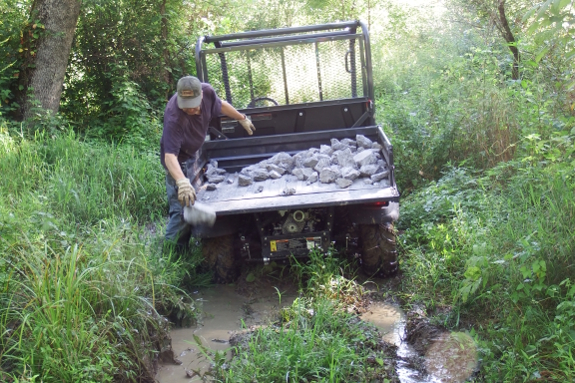
I had far more fun than
I think normal people have on more traditional dates. Mark demonstrated
that sometimes it's better to throw the rocks in the ruts...
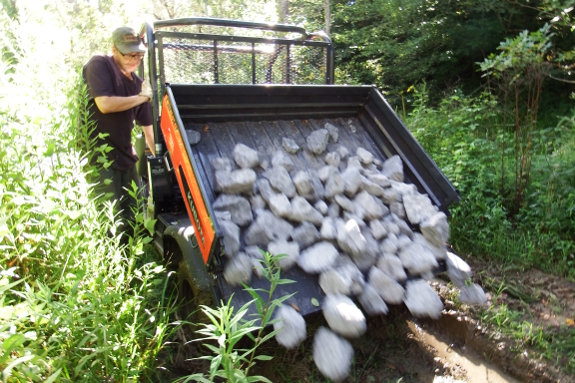
...and sometimes it's
better to dump.

We both came home
mud-speckled but smiling. (Okay, so Mark wasn't smiling as much in this
picture --- it's a bit hard to drive with a camera in your face.) Maybe
I'll play hooky again next week!
Thank you Roland for the idea
of using geotextile fabric to help stabilize the soil.
We like the idea and feel
like a layer of that kind of material in the problem rut areas will
help to make the rock last longer.
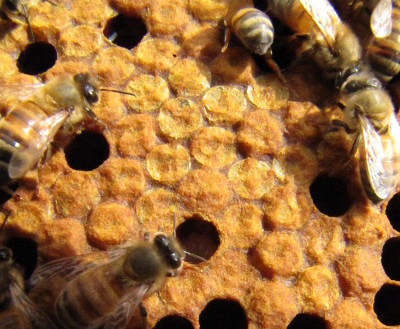 "I’m a longtime reader of your blog and
thought you might want to respond to this
article based on its conclusions that beekeepers that take
alternative approaches to hive maintenance/infection might be
inadvertently harming the larger local bee population by relying on
potentially ineffective virus and mite controls, or worse no controls
whatsoever.
"I’m a longtime reader of your blog and
thought you might want to respond to this
article based on its conclusions that beekeepers that take
alternative approaches to hive maintenance/infection might be
inadvertently harming the larger local bee population by relying on
potentially ineffective virus and mite controls, or worse no controls
whatsoever."Don’t have bees myself, but note that the implication of the study itself may call into question the viability/utility of hobby beekeeping given the potentially negative impact on big agriculture and associated food security resources.
"Anyway, I found it pretty thought-provoking and an opportunity to think critically about the effect homesteading and personalized agriculture, both positive and negative, has on society at large. Perhaps you will as well."
This is definitely an interesting article for backyard beekeepers and I think the author is on the right track in certain ways. On the other hand, I just wish the article had hit the other side of the coin --- that there are ways to deal with mites beyond chemicals.
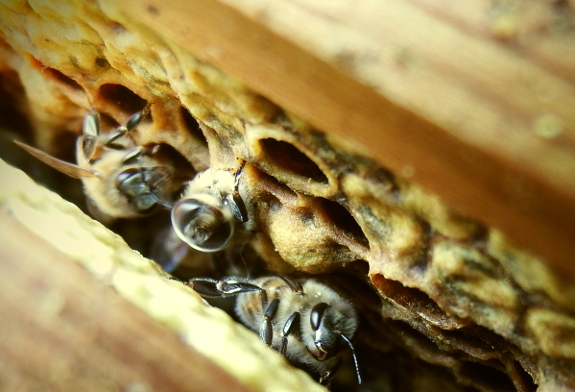 We've had great luck over the
last couple of years using foundationless frames (which leave less room in
brood comb for mites) combined with bees
bred to resist varroa mites (probably hygienic strains,
meaning they groom the mites off). Using both of these techniques, our mite
counts in recent
years have been very low, proving that chemicals aren't the only
solution.
We've had great luck over the
last couple of years using foundationless frames (which leave less room in
brood comb for mites) combined with bees
bred to resist varroa mites (probably hygienic strains,
meaning they groom the mites off). Using both of these techniques, our mite
counts in recent
years have been very low, proving that chemicals aren't the only
solution.But, yes, just ignoring the problem and hoping it goes away is bad for not only your bees but also for those of your neighbors. And the same concept could easily be applied to other facets of homesteading as well. It's a fascinating thought problem to consider how our mini-farms fit into the wider landscape of both factory farming and the wider natural world. Thanks for sharing!
Despite the danger of snakes
we decided to let the chicks roam during the day.
Some chicks prefer to stay in
and watch the others enjoy outdoor life.
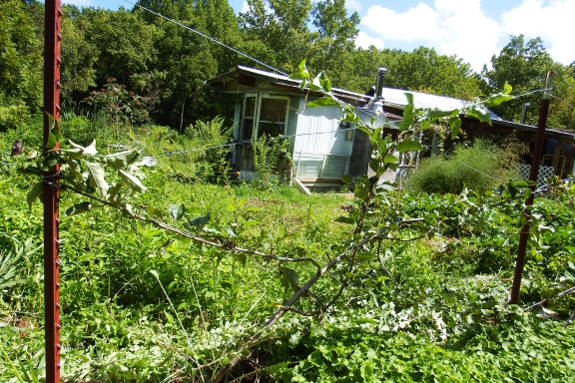
I started our espaliered
apples at the grafting stage, which gave me an extra year of wiggle
room before I had to decide on the shape I planned to train them to.
Then last fall, I
made a simple setup of crossed wires between t-posts and bent the trees
along the lines. But
nine months later, the apples had already outgrown their first training
wires --- time for a second set of supports higher up!
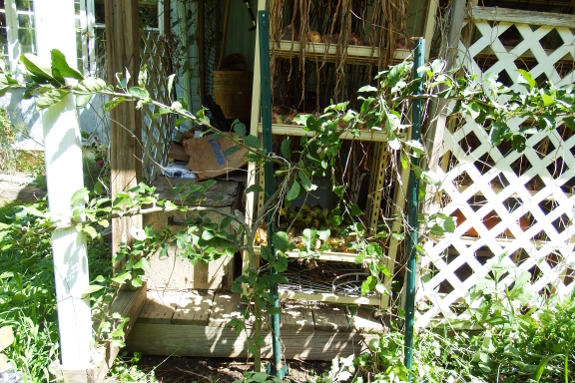
The espaliered apple in
front of the porch got even less formal training. I just bent down
limbs to attach to nearby objects willy-nilly. In the case of both this
tree and those trained to wires, I also bent down or snipped off
secondary branches that were reaching for the sky.
My goal with both sets
of training is pretty simple --- keep the trees two-dimensional and
easily coverable during spring freezes. A few of the trees already have
flower buds, so I might get to test out that hypothesis as early as
next spring (although 2018 is more likely). Here's hoping my 2D apples
are a success!
It's a hard thing to
admit...but I picked the wrong mower.
The Swisher
string mower runs well and I like the 6.75 engine size but our
mixture of weeds and grass is a little too tough for the string which
needs to be replaced a lot when the weeds are high.
A replacement mower would be
self propelled and big with a blade and new enough to have the push
bubble that helps to make starting easier.
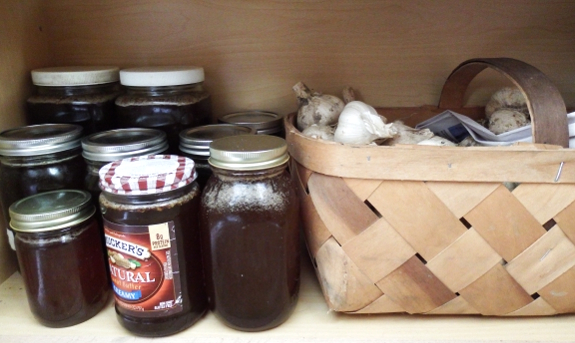
August is make-or-break
month for homegrown winter meals. We're up to 16 gallons of frozen
vegetables, 75% of the way to quota.
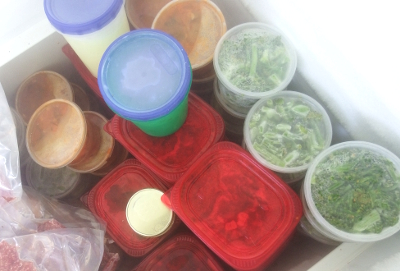 Meanwhile, storage
vegetables are
starting to get packed away as well. I sorted the garlic to ensure we
eat problematic bulbs first, and soon the onions will follow suit. By
the end of the month, we'll refill the curing racks with butternut
squash and sweet potatoes and those will then join their friends in a
kitchen cupboard.
Meanwhile, storage
vegetables are
starting to get packed away as well. I sorted the garlic to ensure we
eat problematic bulbs first, and soon the onions will follow suit. By
the end of the month, we'll refill the curing racks with butternut
squash and sweet potatoes and those will then join their friends in a
kitchen cupboard.
Of course, the real
reason August is so important for winter dining is leafy greens. This
is the month to plant your kale and mustard for fresh, delicious meals
during the cold season. If I was only going to plan on one type of
homegrown food for winter dining, in fact, fall-planted kale would be
it. So if you're looking for the low-hanging fruit, I recommend you
find some seeds and make a little patch of leafy greens today.
The blight seems to be
winning on our tomato plants.
There's still a lot to be
harvested...but soon the blight is going to win.

I'm terrible at leaving
the farm. Luckily, the people I love often find a way to come to me.
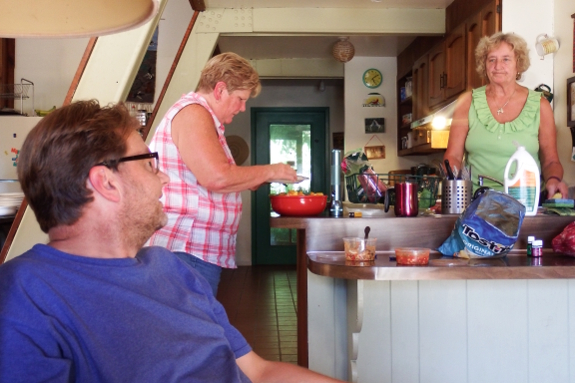
Rose Nell and Jayne are
renting out the nearby community
house for the week, enjoying their vacation while cooking us
delicious dinners. And I even made it home in time to take the goats
out to graze!
Two truck loads of rock have gone a long way in helping our problem areas.
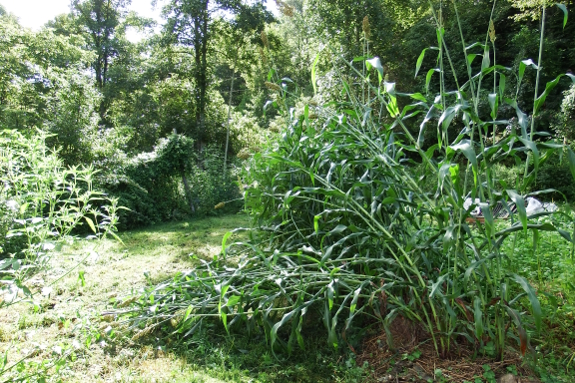
I planted Artemesia's
plot of special treats (aka sorghum) in a very well-mellowed hugelkultur
bed this year. The results were amazing --- the plants shot up so tall
I felt like Jack peering up his beanstalk.
...Then along came a
heavy rain that knocked half of the plants down. I guess that's the
downside of turbo-charged soil.
It's sometimes necessary to give those extraordinarily large plants
some extra support!
Our Chicago Hardy fig continues to bounce back but the Celeste fig on the left seems to have really struggled this year.
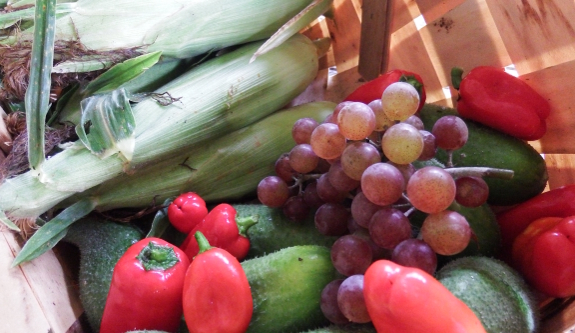
At this time of year, I
sometimes feel like I need to create a horn of plenty for my daily
harvest to spill out of.
This stump is hard to see but was easy to level out thanks to the Oregon battery powered chainsaw.
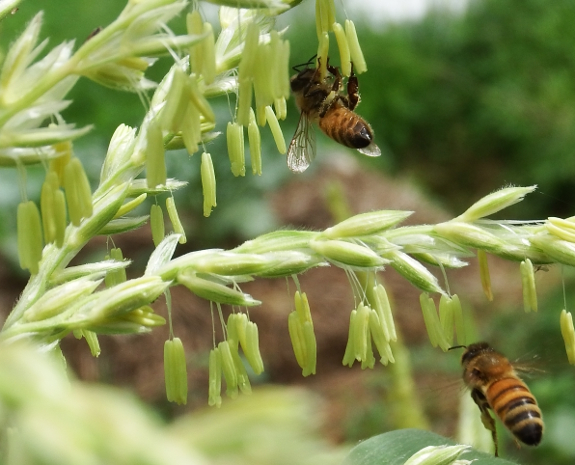
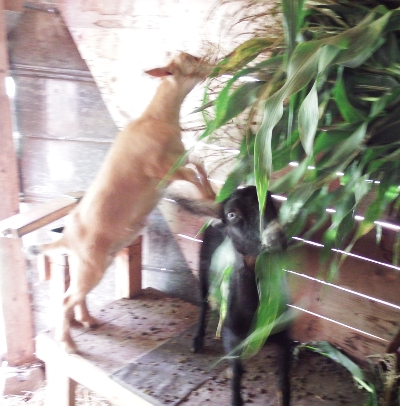 The sweet-corn ecosystem is
quite complex on our farm.
The sweet-corn ecosystem is
quite complex on our farm.
Honeybees steal the pollen fated for tassels (although never so much
that the air doesn't do its job of pollination).
We eat the ears. Then the leaves make great rainy-day goat fodder.
Finally, the stalks often end up as the sop-up-the-effluent
layer at the bottom of a new composting-toilet bin. No part of the
plant is wasted!
The gravel store keeps a
record of every load I've purchased.
Over the last 10 years we've
bought and hauled 330 tons.
Some of that was a huge dump
truck load of crush and run on our main driveway. I will never get
crush and run again. It seemed to fade into the ground rather quickly.
I should've made sure we got 3-4 inch rock for that application.
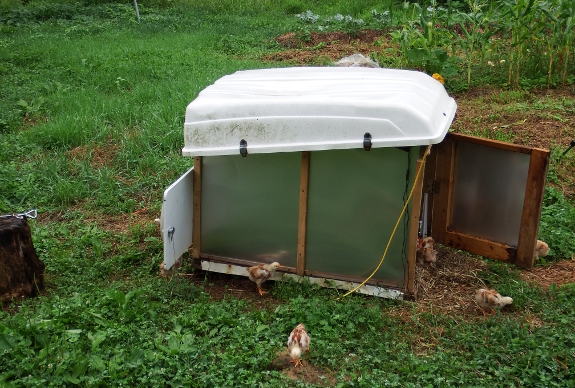
The revamped
brooder has been doing its job admirably.
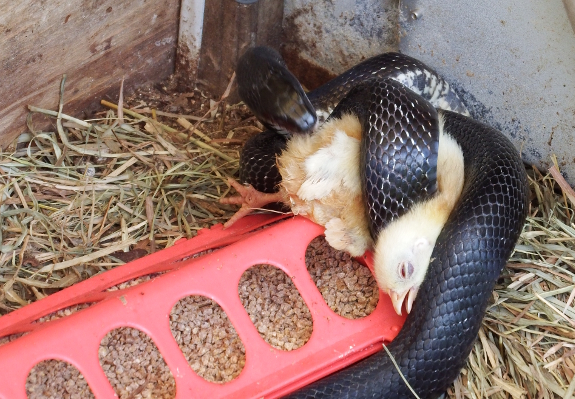
Which means no more of this...
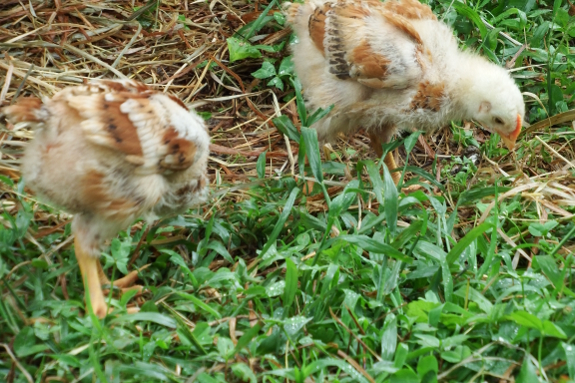
...and plenty of this.
In fact, the only flaw
of the new design is that the flashing on the solid wall tends to heat
the inside up when in direct sunlight. Luckily, the double doors allow
a cross breeze during the day which takes the sting off the oven effect.
High density apple training has produced some impressive results in only 4 years.
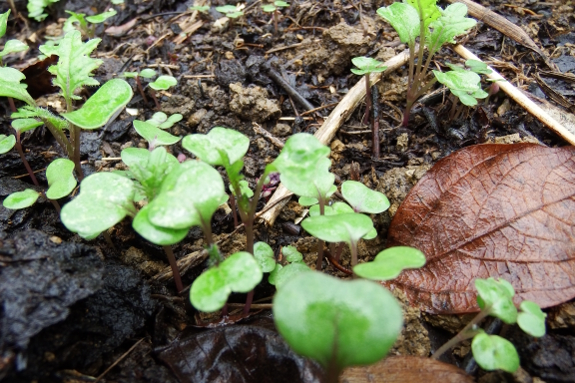
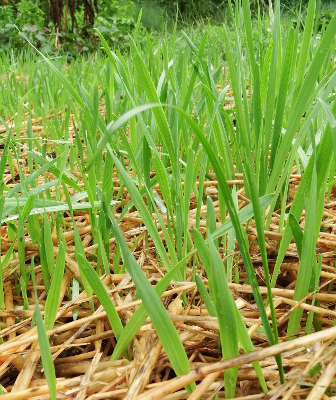 The seasons are subtly
shifting. I've only got a couple weeks left for oat planting, so I'll
be pulling out lots of used-up garden beds and seeding the winter cover
crop this week.
The seasons are subtly
shifting. I've only got a couple weeks left for oat planting, so I'll
be pulling out lots of used-up garden beds and seeding the winter cover
crop this week.
Meanwhile, fall
vegetables are starting to gain a foothold elsewhere in the garden.
Peas and carrots and kale in one area, buckwheat preparing the way for
garlic in another. That, plus a long row of lettuce, is all I have left
to plant in the edible line in 2016.

The new semester at ETSU
starts tomorrow.
I'm having a lot of fun and
learning tons about the process of film making.
To keep things balanced I'll
be skipping my Tuesday post to make time for film.
The above scene is from an upcoming Slasher Spoof titled "Snapped" that
we recently finished production work on.
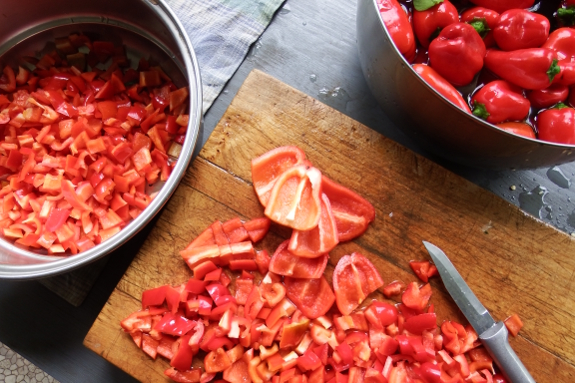
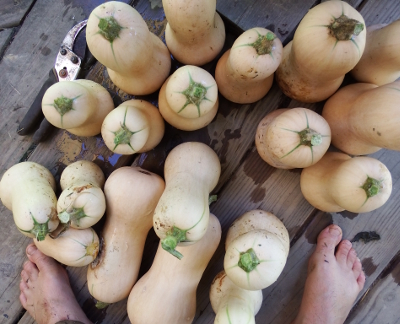 The harvest continues, a
quart of frozen peppers here and a bushel of curing butternuts there.
The harvest continues, a
quart of frozen peppers here and a bushel of curing butternuts there.
Don't worry, Artemesia --- there are many more butternuts still in the
garden for your winter dinners!
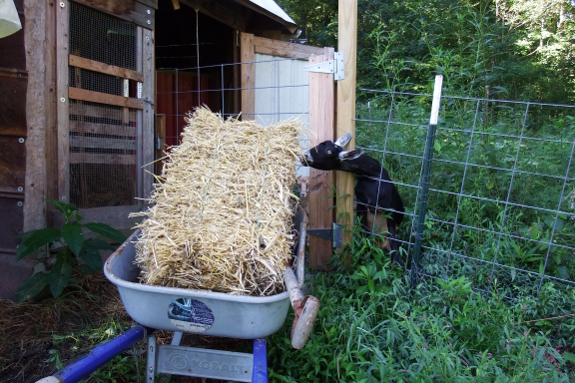
Last year, I
estimated we'd need 27 bales of hay to get our two semi-dwarf goats
through the winter.
We actually socked away 36 bales, though, just to be safe.
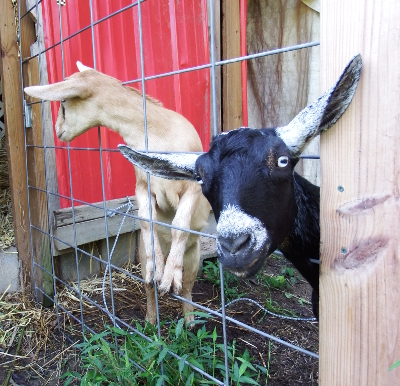 How
much did our goats actually eat? It's a little hard to say because they
spoiled some bales when they broke into the storage area (and I later
used those spoiled bales for bedding). But I'm guessing they actually
consumed somewhere between 18 and 20 bales.
How
much did our goats actually eat? It's a little hard to say because they
spoiled some bales when they broke into the storage area (and I later
used those spoiled bales for bedding). But I'm guessing they actually
consumed somewhere between 18 and 20 bales.
We still have quite a
few musty hay bales from last year in the main barn (outside goat
reach), and I'm trying to decide whether those bales are worth feeding.
I suspect a normal goat would eat them despite a bit of mildew from the
summer damp...but our princesses will likely get fresh bales instead
while I use last year's hay in the garden.
(And, yes, before you
ask --- that bale in the top photo is straw for bedding instead of hay
for dining. Which isn't to say Artemesia didn't nose around in search
of seed heads before settling back into her newly cleaned barn.)
I had some trouble finding
twine in stores around here this Summer.
The twine on Amazon seems
like a better value for 7 dollars.
It seems my Debian browser is
having issues again with Amazon which is why there is no easy link to
the twine.
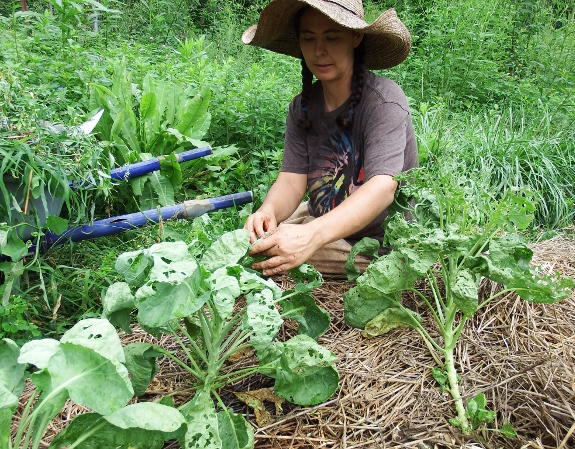
I thought that planting
brussels sprouts early, kill mulching around them to keep down weeds,
then covering
them up with a row cover to beat cabbageworms would
create a set-it-and-forget-it fall crop. But I should have realized
nothing is really set-it-and-forget-it in the garden.
When the lumps under the
row cover stopped looking regular, I finally removed the fabric and
took a look. Many plants had been stunted and two thirds of them had
outright died, leaving us about as many good plants as last year.
What was the culprit?
One of our cats jumped on the row cover and broke a hole in the area
pictured above...and that turned out to be the healthiest part of the
row (except for holes in leaves from sneaky cabbageworms). As a result,
my guess is that the row cover heated up the plants too much, causing
some to flounder and others to perish. Looks like we'll have to go back
to the usual bug-squishing routine in future!
I used the Ninja
blade attachment today to
cut down mature Rag Weeds.
Some of the stems are tough
enough to take several passes to cut through.
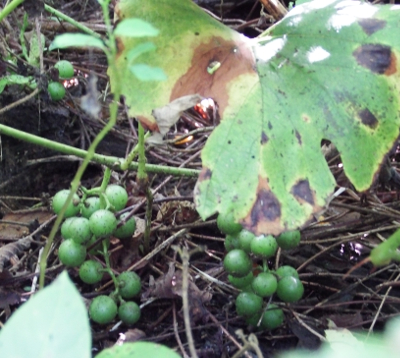 My
best guess was that the found grapevine near the site of the old
homeplace on our farm was a Concord. So when Mom's Concord started
churning out so many ripe fruits she had to embark on a daily juicing
session, I braved the thorns and weeds and went to take a second look
at my mystery vine.
My
best guess was that the found grapevine near the site of the old
homeplace on our farm was a Concord. So when Mom's Concord started
churning out so many ripe fruits she had to embark on a daily juicing
session, I braved the thorns and weeds and went to take a second look
at my mystery vine.
To my surprise, the
grapes are still green and very much unripe. Let's see if I can
remember to check on the vine again in a couple of weeks to discover
what color they become as they soften up.
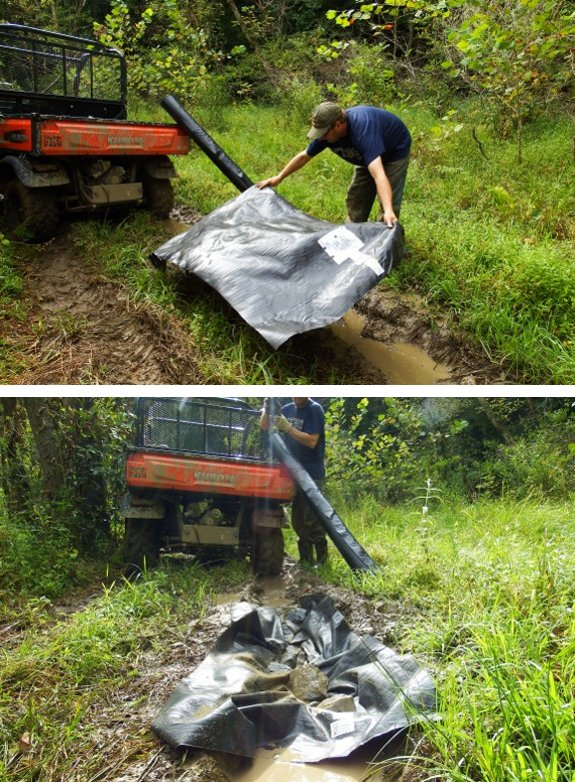
I've got a good feeling about
our new geotextile
fabric experiment.
Anna estimates it will take
about 100 of the above lengths to fill our problem ruts.
Two down and only ninety
eight
to go.
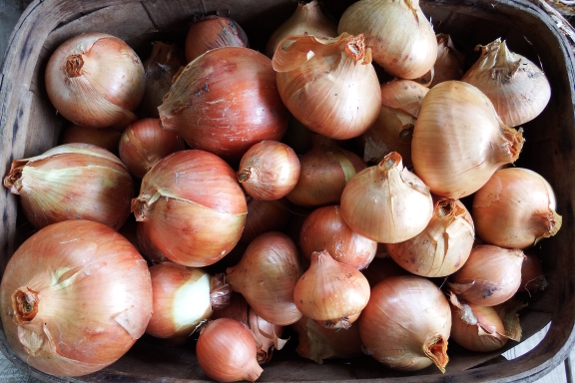
After putting a
massive number of onions onto the curing racks a
month ago, I mostly forgot about them. Well, I did bring in dozens of
the largest specimens for soup-making during that time period, packing
away perhaps as much as a quarter of the harvest into frozen winter
dinners.
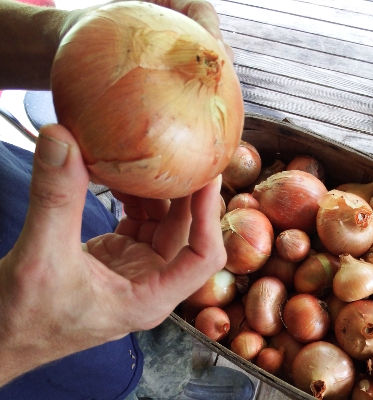 Soon, though, the curing
racks will need to be emptied out for the sake of butternut squash and
sweet potatoes. So I took an hour to cut off dried roots and leaves,
shucking outer skins and sorting the onion bulbs.
Soon, though, the curing
racks will need to be emptied out for the sake of butternut squash and
sweet potatoes. So I took an hour to cut off dried roots and leaves,
shucking outer skins and sorting the onion bulbs.
The weather was crazy
wet during harvest and early curing season, so I wasn't surprise to
have quite a bit of rot to deal with. On the other hand, I was surprised to realize I had
so many onions available that I could simply give the worst half bushel
away.
All told, post-souping
and rehoming, we ended up with about 63 pounds of onions, or around a
bushel and a half. This is definitely the most we've ever managed to
sock away. Perhaps this will be the second year that we won't buy any
onions (our former Achilles heel) in the store?
 In November of 2014, I began a journey with
essential oils when a friend invited me to a short class. I knew
virtually nothing about essential oils, but I succumbed the minute the
woman teaching the class mentioned one drop of Valor will quieten or
stop snoring. What a statement! My husband the snorer! I obtained
a bottle of Valor that very night and we actually went from a loud roar
to a dull hum.
In November of 2014, I began a journey with
essential oils when a friend invited me to a short class. I knew
virtually nothing about essential oils, but I succumbed the minute the
woman teaching the class mentioned one drop of Valor will quieten or
stop snoring. What a statement! My husband the snorer! I obtained
a bottle of Valor that very night and we actually went from a loud roar
to a dull hum.
Our next success was
Mac's chronic bronchitis, which usually requires treatment all winter
long. We began preemptively using Eucalyptus
globulus instead
and my husband escaped without a single bout.
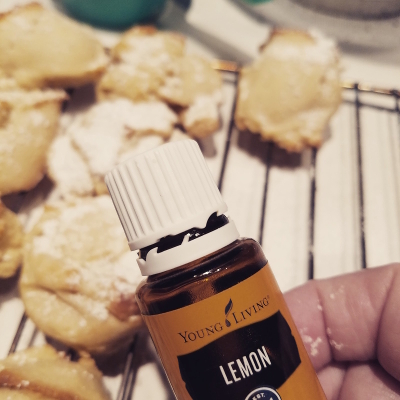 So what are essential oils?
Simply put, essential oils are the life blood of plants. When you
pinch a leaf from a plant and it oozes some "juice," that is the oil.
These juices contain molecules so tiny they can get into the entire
body within twenty minutes when placed anywhere on your skin. That is
why when you put a drop of Peppermint on your temples, you can say bye
bye to pain.
So what are essential oils?
Simply put, essential oils are the life blood of plants. When you
pinch a leaf from a plant and it oozes some "juice," that is the oil.
These juices contain molecules so tiny they can get into the entire
body within twenty minutes when placed anywhere on your skin. That is
why when you put a drop of Peppermint on your temples, you can say bye
bye to pain.
So how do you use them?
The first choice for beginners is often to begin "low and slow" by
applying oils topically onto the skin in an area where you are looking
for support. The soles of your feet are a good choice for this type of
application.
 Alternatively, you can inhale the essential
oils. Perhaps you merely place a drop in your hand then inhale with
your palm cupped over your nose. Or you may diffuse the scent through
the air using a cold-air diffuser.
Alternatively, you can inhale the essential
oils. Perhaps you merely place a drop in your hand then inhale with
your palm cupped over your nose. Or you may diffuse the scent through
the air using a cold-air diffuser.
Finally, essential oils
can be taken internally. For example, place a drop of Lemon in your
glass of ice water to cleanse toxins and boost energy.
No matter how you get
the oils into your system, they're a great option for those needing
emotional support and support for their nervous system. More
personally, they've changed both my and my husband's lives for the
better. Perhaps you'd like to give them a try as well?
Nancy
McKinney is an independent distributor of Young Living Essential Oils.
For more information, you can find her on facebook, on her blog, or by
emailing nkmckinney@gmail.com.
A nice action shot of Anna helping throw rocks and enjoying every minute of it.
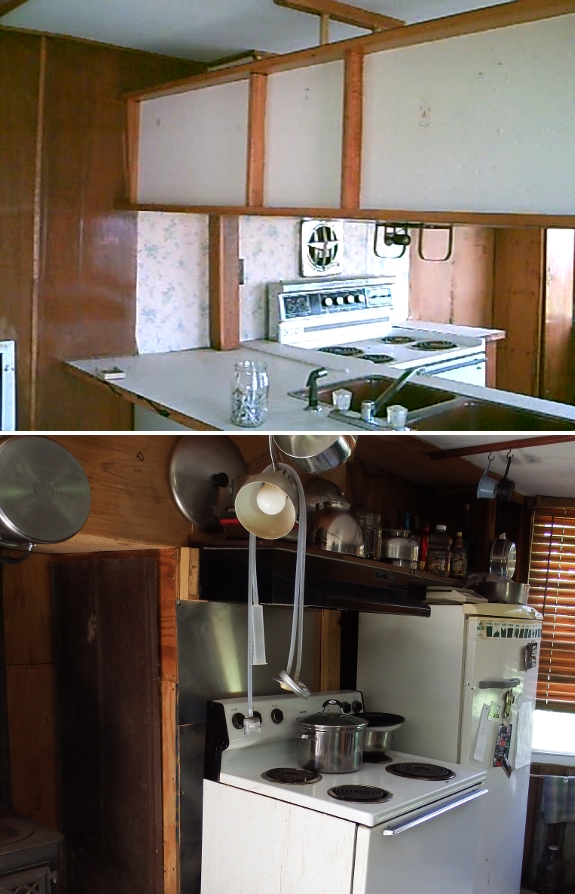
Early September 2016
will mark our ten-year anniversary of time spent on the farm. To
celebrate, I plan to make a few posts off and on in which I try to
recreate the same photo from the past as accurately as possible. For
example, the shots above show the south wall of our kitchen then and
now.
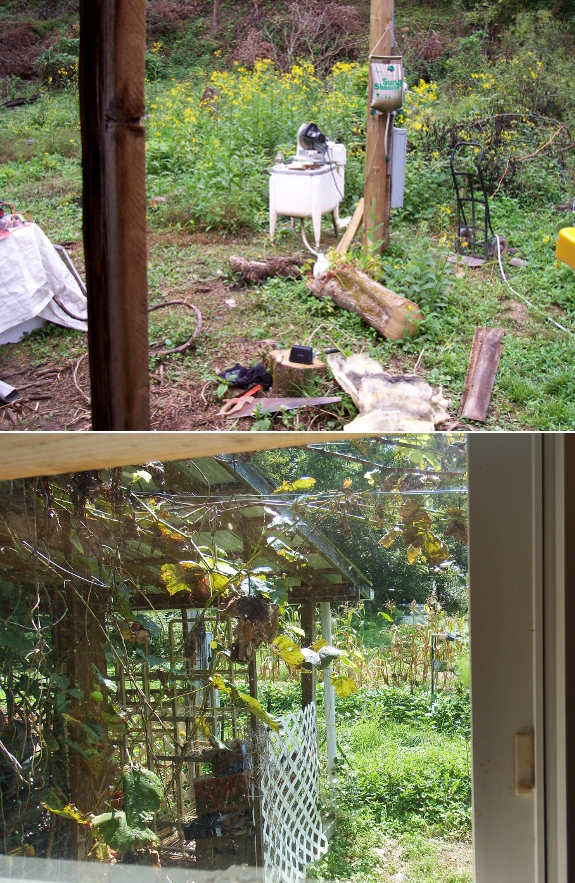
And here's the view out
the front windows before there were windows and after we completed our
passive-solar wall.
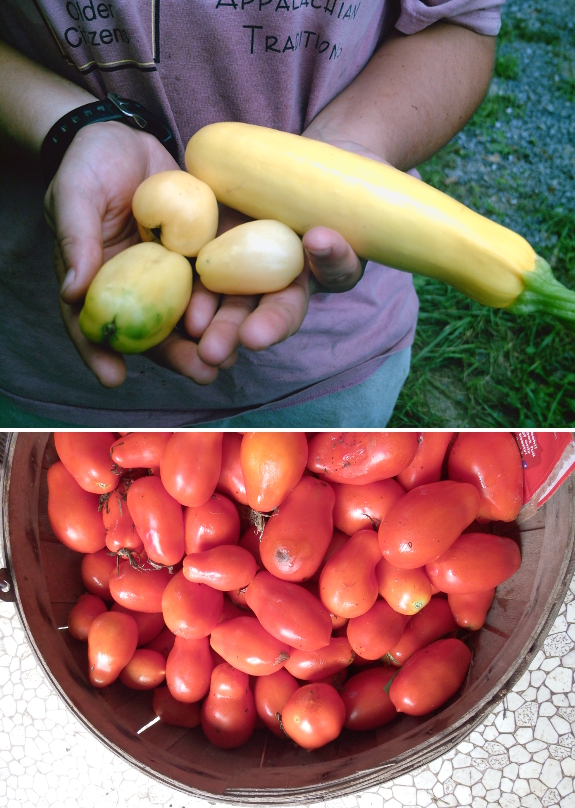
Finally, the last duo
includes the very first fruits of the farm compared to last week's
tomato harvest. Yes, we've come a long way in a decade!
The field corn did pretty
good this year.
Nearly a bushel basket full.
Once it's dried we'll store
it for Winter
goat treats.
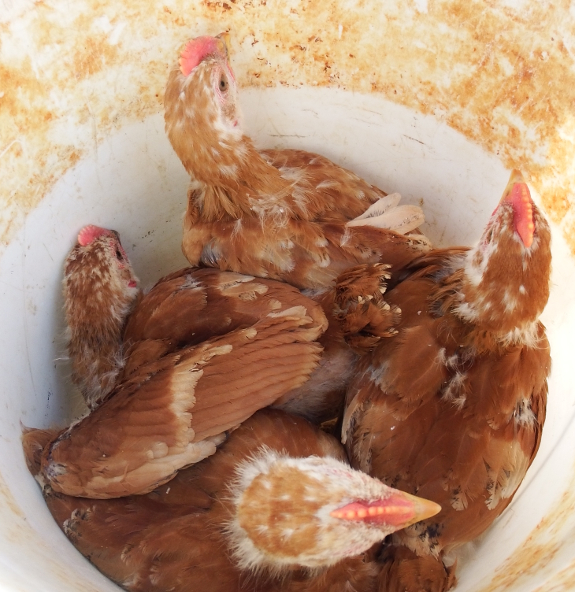
At one month old, our
Red Rangers are really ranging. They've wandered all the way around the
trailer to check out the garden, porch, and dogfood on the other side
and are leaving little presents 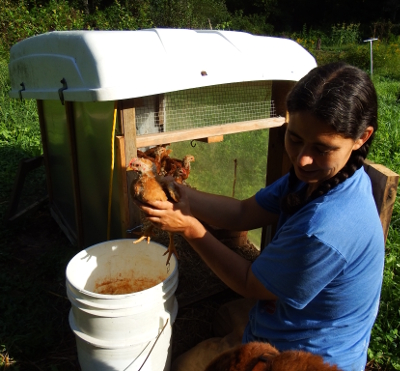 where I don't particularly
want to step in them. Time to move the flock into a fenced-in pasture!
where I don't particularly
want to step in them. Time to move the flock into a fenced-in pasture!
When Mark
revamped our brooder this summer, he did so with the inevitable
moving day in mind. The new big door on one end makes it easy to reach
all the way inside to snag skittish chicks while the smaller door on
the other end lets Mark play goalie, herding the cockerels in my
direction. Dropping them four at a time into a six-gallon bucket makes
it easy to carry the flighty critters to the home where they'll live
for two more months until freezer day. Nice work on easing what can
sometimes be a difficult task, Mark!
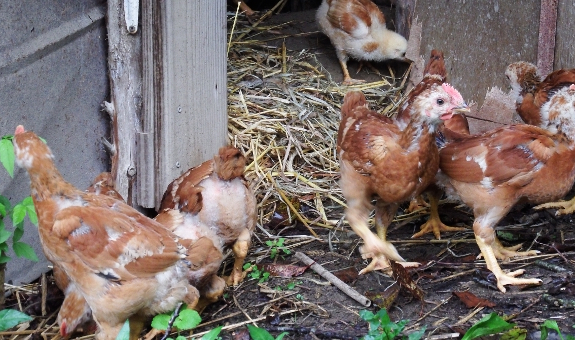
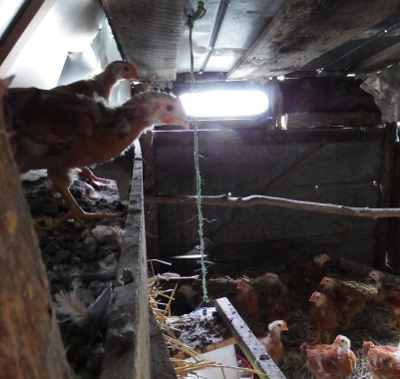 Our
Red Rangers said they were very much ready to enter
the big-bird world of the coop. In fact, after being shut inside
for a day to reset their homing sensors, I found two of the broilers
perched four feet above the ground on top of the nest boxes. And when I
finally opened the door, they were very much ready to roam.
Our
Red Rangers said they were very much ready to enter
the big-bird world of the coop. In fact, after being shut inside
for a day to reset their homing sensors, I found two of the broilers
perched four feet above the ground on top of the nest boxes. And when I
finally opened the door, they were very much ready to roam.
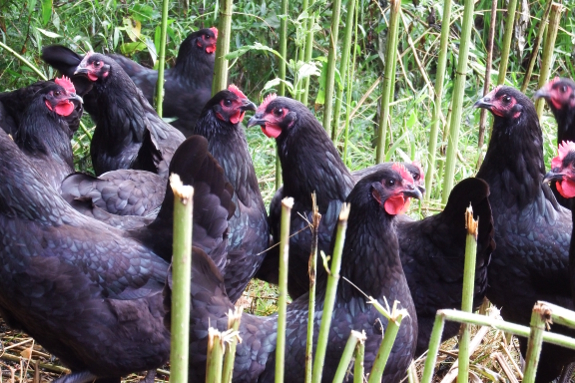
The displaced Australorp
pullets, recently moved out of the starter coop and into our other
coop, are more skittish. They've been hanging out just outside the coop
door amid the stalks of recently cut ragweed rather than exploring
their new pasture.
...which is really a
good thing since I like Australorps' tendency to be shy and people
averse. Here's hoping this year's unicolor flock will be better behaved
than last year's colorful but problematic layers.
I've had this hand
cranked radio since I got it at a post Y2K clearance sale.
It comes in handy for power
failures like on Monday. Just crank it 50 times and you've got
about 20 minutes of radio.
The solar cell needs direct
sun and does not charge a battery.
A bonus feature is a DC out
jack that allows something small and external to run off the powerful
spring winder.
Want more in-depth information? Browse through our books.
Or explore more posts by date or by subject.
About us: Anna Hess and Mark Hamilton spent over a decade living self-sufficiently in the mountains of Virginia before moving north to start over from scratch in the foothills of Ohio. They've experimented with permaculture, no-till gardening, trailersteading, home-based microbusinesses and much more, writing about their adventures in both blogs and books.
